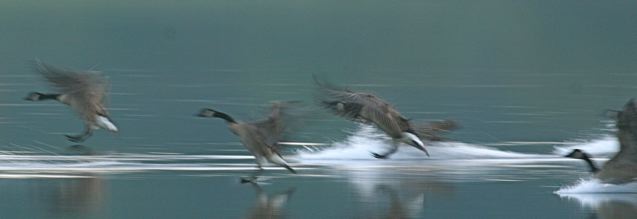
What a cold night! Temperatures in the single digits! Again I thought of how the birds are coping with cold.
Chuck Tague’s photo of Canada geese coming in for a landing made me wonder how they can swim in near freezing river water and stand on ice for hours. It turns out that birds have special adaptions to keep themselves warm.
Feathers are one big advantage. Not only do they naturally conserve heat but the feathers closest to a bird’s skin are downy. Birds fluff their feathers to expand the down when the weather’s cold, making the little birds look like butterballs.
You can see the effect of feather insulation at this link showing infrared photos of a parrot on a person’s arm. The person’s arm looks “hot” but the parrot’s body looks “cool” because its feathers are such good insulation.
Another cold weather advantage for ducks and geese are their waterproof feathers and a layer of fat under their skin. The fat keeps them warm in cold water and their feathers keep them dry.
This leaves the problem of warming their feet. Birds can tuck a foot up under their feathers but this is impractical for very long.
So how can geese stand on ice in their bare feet? Water birds have an unusual circulatory system in their legs and feet. The veins and arteries in their legs are intertwined so that cold blood leaving their feet is warmed by the arteries delivering warm blood. (Open the comments below for a more accurate explanation from Dr. Bledsoe of Univ of Pittsburgh.)
Perhaps this means birds’ feet are a little colder all the time, but it doesn’t bother them. The advantage is that their central body doesn’t have to cope with cold blood returning directly to their hearts.
We humans don’t have these advantages so my feet are mighty glad they’re indoors right now.
(photo by Chuck Tague)
The unusual adaptation in the feet of many birds that experience cold weather actually operates as a counter-current exchange system, so that nearly all of the warmth in the descending blood is transferred to the ascending blood. It’s just one of many examples of that highly efficient way of transferring from one fluid or gas to another. A second example in birds involves their lungs. Unlike mammals, which have bulk flow respiration, air in the lungs of birds actually passes over the gas exchange surfaces in only one direction, with the blood of the lungs passing in the other direction. This allows for nearly complete uptake of oxygen from the blood, and almost complete depletion of carbon dioxide from the blood.
Thanks for that information. I live across from the Kiski River and it amazes me that the geese (we have anywhere from 30-80 who spend time in a farm field behind me, and wander up into the beginning of my back yard at times) look like they are just cruising/swimming upstream in between the chunks of ice or they sit on a huge pond that is 2/3 frozen some days. The pond is in an industrial park not far from me also. Now I know how they do it.